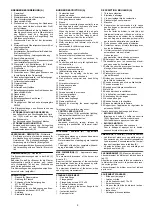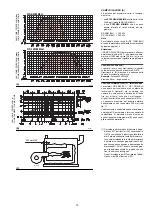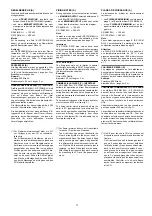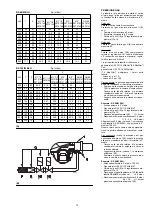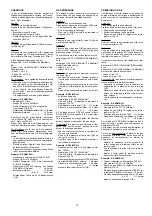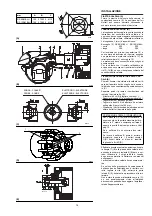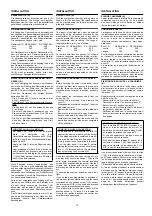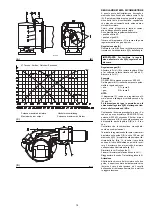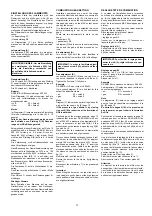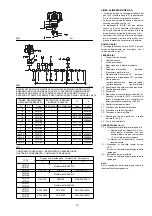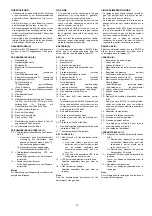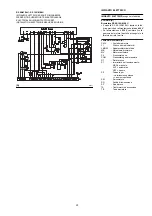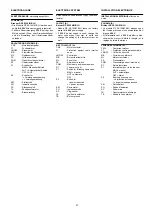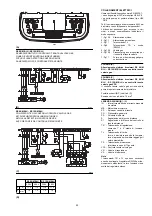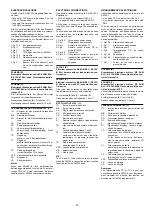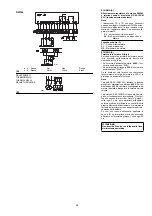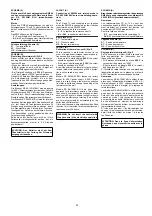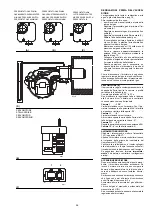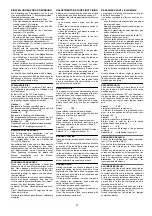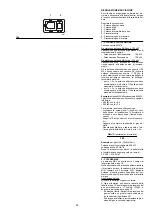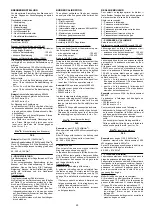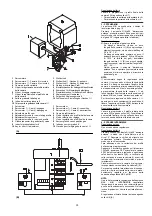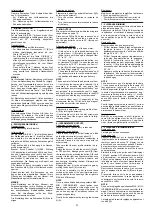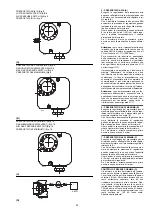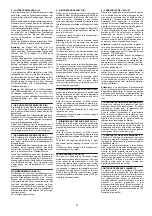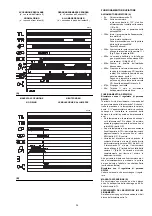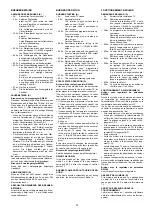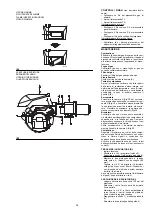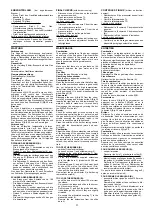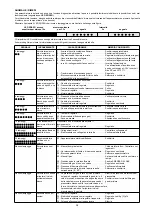
23
ELEKTROANSCHLÜSSE
Gemäß Norm EN 60 335-1 biegsame Kabel ver-
wenden:
• falls unter PVC-Mantel mindestens den Typ
H05 VV-F verwenden.
• falls unter Gummimantel mindestens den Typ
H05 RR-F verwenden.
Alle mit der Klemmenleiste 9)(A) des Brenners
zu verbindenden Kabel sind durch die entspre-
chenden Kabeldurchgänge zu führen.
Die Kabeldurchgänge können auf verschiedene
Arten genutzt werden. Als Beispiel führen wir
die folgenden Arten auf:
1- Pg 13,5
Dreiphasenspeisung
2- Pg 11
Einphasenspeisung
3- Pg 11
TL-Regler
4- Pg 9
TR-Regler oder Fühler (RWF40)
5- Pg 13,5
Gasventile
6- Pg 13,5
Gasdruckwächter oder Dichtheits-
kontrolle VPS
7- Pg 11
Bohren, falls man wünscht, noch
einen Anschlusstutzen einzuset-
zen
SCHEMA (B)
Elektrischer Brenneranschluß RS 68/M BLU -
RS 120/M BLU ohne Dichtheitskontrollein-
richtungen.
SCHEMA (C)
Elektrischer Brenneranschluß RS 68/M BLU -
RS 120/M BLU mit Dichtheitskontrolleinrich-
tungen VPS.
Die Dichtheitskontrolle der Gasventile erfolgt
umgehend vor jedem Brennerstart.
Sicherungen Schemen (B-C), siehe Tab. (D).
Nicht angegebener Kabelquerschnitt: 1,5 mm
2
.
ZEICHENERKLÄRUNG SCHEMEN (B) - (C)
IN
- Schalter für das manuelle Ausschalten
des Brenners
MB
- Klemmbrett Brenner
XP
- Stecker für die Dichtheitskontrolleinrich-
tung
PG
- Gas-Minimaldruckwächter
PS
- Entriegelungsschalter
S
- Fernmeldung Störabschaltung
S1
- Fernmeldung Störabschaltung Dicht-
heitskontrolle
TR
- Regelung:
steuert 1. und 2. Betriebsstadium
TL
- Regelung:
schaltet den Brenner aus, wenn die Tem-
peratur oder der Kesseldruck den festge-
legten Wert überschreiten.
TS
- Sicherheitsregelung:
tritt bei Defekt an TL in Aktion.
VPS - Dichtheitskontrolle der Gasventile
VR
- Regelventil
VS
- Sicherheitsventil
Merke
Wenn das RWF40 für den modulierenden
Betrieb angeschlossen ist, sind die Fernsteue-
rungen TR und TL nicht erforderlich, da deren
Funktionen vom RWF40 übernommen werden.
ELECTRICAL CONNECTIONS
Use flexible cables according to EN 60 335-1
Regulations:
• if in PVC sheath, use at least H05 VV-F
• if in rubber sheath, use at least H05 RR-F.
All the wires to connect to the burner terminal
strip 9)(A) must enter through the supplied fair-
leads.
The fairleads and hole press-outs can be used
in various ways; the following lists show one
possible solution:
1- Pg 13,5
Three-phase power supply
2- Pg 11
Single-phase power supply
3- Pg 11
Remote control device TL
4- Pg
9
Remote control device TR or
probe (RWF40)
5- Pg 13,5
Gas valves
6- Pg 13,5
Gas pressure switch or gas valve
leak detection control device
7- Pg 11
Open the hole, if a pipe union is to
be added
LAYOUT (B)
Electrical connection RS 68/M BLU - RS 120/
M BLU burners without leak detection con-
trol device.
LAYOUT (C)
Electrical connection RS 68/M BLU - RS 120/
M BLU burners with VPS leak detection con-
trol device.
Gas valve leak detection control takes place
immediately before every burner start-up.
Fuses layouts (B) and (C), see table (D).
Cross-section when not indicated: 1,5 mm
2
.
KEY TO LAYOUTS (B) - (C)
IN
- Burner manual stop switch
MB
- Burner terminal strip
XP
- Plug for leak detection control device
PG
- Min. gas pressure switch
PS
- Lock-out reset button
S
- Remote lock-out signal
S1
- Remote lock-out signal of leak detection
control device
TR
- High-low mode load remote control sys-
tem:
controls operating stages 1 and 2.
TL
- Load limit remote control system:
shuts down the burner when the boiler
temperature or pressure reaches the
preset value.
TS
- Safety load control system:
operates when TL is faulty.
VPS - Leak detection control device
VR
- Adjustment valve
VS
- Safety valve
N.B.
The TR and TL load controls are not required
when the RWF40 is connected, as their function
is performed by the RWF40 itself.
BRANCHEMENTS ELECTRIQUES
Utiliser des câbles flexibles selon la norme EN
60 335-1:
• si en gaine PVC, au moins type H05 VV-F
• si en gaine caoutchouc, au moins type H05
RR-F.
Tous les câbles à raccorder au porte-bornes
9)(A) du brûleur doivent passer par les passe-
câbles. L'utilisation des passe-câbles et des
trous prédécoupés peut se faire de plusieurs
façons; à titre d'exemple nous indiquons l'une
de ces possibilités:
1- Pg 13,5
Alimentation triphasée
2- Pg 11
Alimentation monophasée
3- Pg 11
Télécommande TL
4- Pg
9
Télécommande TR ou sonde
(RWF40)
5- Pg 13,5
Vannes gaz
6- Pg 13,5
Pressostat gaz ou contrôle d'étan-
chéité vannes gaz
7- Pg
11
Percer, si l'on veut ajouter un
presse-étoupe
SCHEMA (B)
Branchement électrique brûleur RS 68/M
BLU - RS 120/M BLU sans dispositif de con-
trôle d'étanchéité.
SCHEMA (C)
Branchement électrique brûleur RS 68/M
BLU - RS 120/M BLU avec dispositif de con-
trôle d'étanchéité VPS.
Le contrôle d'étanchéité des vannes se fait juste
avant chaque mise en marche du brûleur.
Fusibles schemas (B-C), voir tab. (D).
Section câbles non indiquée: 1,5 mm
2
.
LEGENDE SCHEMAS (B) - (C)
IN
- Interrupteur électrique pour arrêt manuel
brûleur
MB
- Porte-bornes brûleur
XP
- Fiche pour le contrôle d'étanchéité
PG
- Pressostat gaz seuil minimum
PS
- Bouton de déblocage
S
- Signalisation blocage brûleur à distance
S1
- Signalisation blocage contrôle d'étan-
chéité à distance
TR
- Télécommande de réglage:
commande 1ère et 2ème allure de fonc-
tionnement.
Si l’on désire un brûleur à fonctionne-
ment à une seule allure, remplacer TR
par un pontet.
TL
- Télécommande de limite:
arrête le brûleur quand la température ou
la pression dans la chaudière a atteint la
valeur fixée.
TS
- Télécommande de sécurité:
intervient quand le TL tombe en panne
VPS - Dispositif de contrôle d'étanchéité
VR
- Vanne de réglage
VS
- Vanne de sécurité
Remarque
Les télécommandes TR et TL ne sont pas
nécessaires quand le RWF40, pour fonctionne-
ment modulant, est branché: leur fonction est
assurée par le RWF40 proprement dit.
Summary of Contents for 3897402
Page 2: ......

